PTAA for Perovskite Applications
CAS Number 1333317-99-9
Interface Polymers, Materials, Perovskite Interface Materials, Perovskite Materials, Semiconducting Polymers
PTAA, to substantially improve PCE of perovskite solar cells
High quality HTL and EBL semiconducting material
Overview | Specifications | MSDS | Pricing and Options | Literature and Reviews
Poly[bis(4-phenyl)(2,4,6-trimethylphenyl)amine (PTAA), CAS number 1333317-99-9, one of the family members of poly(triaryl)amine, is an excellent hole-transporting and electron-blocking semiconducting material due to its electron-rich components. It is a popular choice for perovskite solar cell devices, due to its:
- Easy processibility
- Good hole transport and electron blocking qualities
- High thermal stability
- Use in both regular and inverted devices
PTAA from Ossila was used in the high-impact paper (IF 30.85), Multiply Charged Conjugated Polyelectrolytes as a Multifunctional Interlayer for Efficient and Scalable Perovskite Solar Cells, E. Jung et al., Adv. Mater., 2002333 (2020); DOI: 10.1002/adma.202002333.

Semiconducting material
High quality HTL and EBL semiconducting material
Improve open circuit voltage
(Voc) and fill factor (FF)
High Quality
High quality & Electron Rich

Hole-transport layer
improved device performance
General Information
| CAS number | 1333317-99-9 |
| Chemical formula | (C21H19N)n |
| Molecular weight | Please see batch details |
| HOMO / LUMO | HOMO 5.25 eV LUMO 2.30 eV [6] |
| Recommended solvents | Chlorobenzene, chloroform, dichlorobenzene and toluene |
| Synonyms |
|
| Classification / Family | Polyamines, Hole-transport layer materials, Electron-blocking layer materials, Organic semiconducting materials, Organic photovoltaics, Polymer solar cells, OLED materials |
Chemical Structure

Notable Device Performances using PTAA
| JSC | VOC | FF | PCE | Ref |
| 16.5 mA/cm2 | 0.997 V | 72.7% | 12.0% | (Heo et al., 2013) |
| 21.84 mA/cm2 | 1.114 | 73.6% | 17.91% | (Jeon et al., 2015) |
| 24.7 mA/cm2 | 1.06 | 77.5% | 20.2% | (Yang et al., 2015) |
| 25.7 mA/cm2 | 1.118 | 82.3% | 25.0% | (Li et al., 2022) |
MSDS Documentation
Pricing
| Batch | Quantity | Price |
| M0511A8/A9/A13 | 100 mg | £250 |
| M0511A8/A9/A12/A13 | 250 mg | £500 |
| M0511A8/A9 | 500 mg | £900 |
| M0511A8/A9 | 1 g | £1500 |
| M0511A12/A13 | 500 mg | £950 |
| M0511A12/A13 | 1 g | £1800 |
Free worldwide shipping on qualifying orders.
Batch details
| Batch* | Mw | Mn | PDI | Stock info |
| M0511A5 | 25,000 | 12,500 | 2.0 |
Discontinued |
| M0511A6 | 13,000 | 8,667 | 1.5 | Discontinued |
| M0511A7 | 30 kDa | 12.5 kDa | 2.4 | Discontinued |
| M0511A8 | 56 kDa | 19.5 kDa | 2.87 | In Stock |
| M0511A9 | 11 kDa | 6.9 kDa | 1.60 | In Stock |
| M0511A12 | 30 kDa | 15.7 kDa | 1.91 | In Stock |
| M0511A13 | 27 kDa | 18 kDa | 1.50 | In Stock |
*Older batch information available on request.
Literature and Reviews
- Efficient inorganic–organic hybrid heterojunction solar cells containing perovskite compound and polymeric hole conductors, J. Heo et al., Nat. Photonics 7, 486–491 (2013) doi:10.1038/nphoton.2013.80.
- Compositional engineering of perovskite materials for high-performance solar cells, N. Jeon et al., Nature 517, 476–480 (2015), doi:10.1038/nature14133.
- High-performance photovoltaic perovskite layers fabricated through intramolecular exchange, W-S. Yang et al., Science, 348 (6240), 1234-1237 (2015). DOI: 10.1126/science.aaa9272.

 PTAA (Perovskite) MSDS sheet
PTAA (Perovskite) MSDS sheet